Samsung SSD 840 EVO Review: 120GB, 250GB, 500GB, 750GB & 1TB Models Tested
by Anand Lal Shimpi on July 25, 2013 1:53 PM EST- Posted in
- Storage
- SSDs
- Samsung
- TLC
- Samsung SSD 840
AnandTech Storage Bench 2011
Two years ago we introduced our AnandTech Storage Bench, a suite of benchmarks that took traces of real OS/application usage and played them back in a repeatable manner. I assembled the traces myself out of frustration with the majority of what we have today in terms of SSD benchmarks.
Although the AnandTech Storage Bench tests did a good job of characterizing SSD performance, they weren't stressful enough. All of the tests performed less than 10GB of reads/writes and typically involved only 4GB of writes specifically. That's not even enough exceed the spare area on most SSDs. Most canned SSD benchmarks don't even come close to writing a single gigabyte of data, but that doesn't mean that simply writing 4GB is acceptable.
Originally I kept the benchmarks short enough that they wouldn't be a burden to run (~30 minutes) but long enough that they were representative of what a power user might do with their system.
Not too long ago I tweeted that I had created what I referred to as the Mother of All SSD Benchmarks (MOASB). Rather than only writing 4GB of data to the drive, this benchmark writes 106.32GB. It's the load you'd put on a drive after nearly two weeks of constant usage. And it takes a *long* time to run.
1) The MOASB, officially called AnandTech Storage Bench 2011 - Heavy Workload, mainly focuses on the times when your I/O activity is the highest. There is a lot of downloading and application installing that happens during the course of this test. My thinking was that it's during application installs, file copies, downloading and multitasking with all of this that you can really notice performance differences between drives.
2) I tried to cover as many bases as possible with the software I incorporated into this test. There's a lot of photo editing in Photoshop, HTML editing in Dreamweaver, web browsing, game playing/level loading (Starcraft II & WoW are both a part of the test) as well as general use stuff (application installing, virus scanning). I included a large amount of email downloading, document creation and editing as well. To top it all off I even use Visual Studio 2008 to build Chromium during the test.
The test has 2,168,893 read operations and 1,783,447 write operations. The IO breakdown is as follows:
| AnandTech Storage Bench 2011 - Heavy Workload IO Breakdown | ||||
| IO Size | % of Total | |||
| 4KB | 28% | |||
| 16KB | 10% | |||
| 32KB | 10% | |||
| 64KB | 4% | |||
Only 42% of all operations are sequential, the rest range from pseudo to fully random (with most falling in the pseudo-random category). Average queue depth is 4.625 IOs, with 59% of operations taking place in an IO queue of 1.
Many of you have asked for a better way to really characterize performance. Simply looking at IOPS doesn't really say much. As a result I'm going to be presenting Storage Bench 2011 data in a slightly different way. We'll have performance represented as Average MB/s, with higher numbers being better. At the same time I'll be reporting how long the SSD was busy while running this test. These disk busy graphs will show you exactly how much time was shaved off by using a faster drive vs. a slower one during the course of this test. Finally, I will also break out performance into reads, writes and combined. The reason I do this is to help balance out the fact that this test is unusually write intensive, which can often hide the benefits of a drive with good read performance.
There's also a new light workload for 2011. This is a far more reasonable, typical every day use case benchmark. Lots of web browsing, photo editing (but with a greater focus on photo consumption), video playback as well as some application installs and gaming. This test isn't nearly as write intensive as the MOASB but it's still multiple times more write intensive than what we were running in 2010.
As always I don't believe that these two benchmarks alone are enough to characterize the performance of a drive, but hopefully along with the rest of our tests they will help provide a better idea.
The testbed for Storage Bench 2011 has changed as well. We're now using a Sandy Bridge platform with full 6Gbps support for these tests.
AnandTech Storage Bench 2011 - Heavy Workload
We'll start out by looking at average data rate throughout our new heavy workload test:
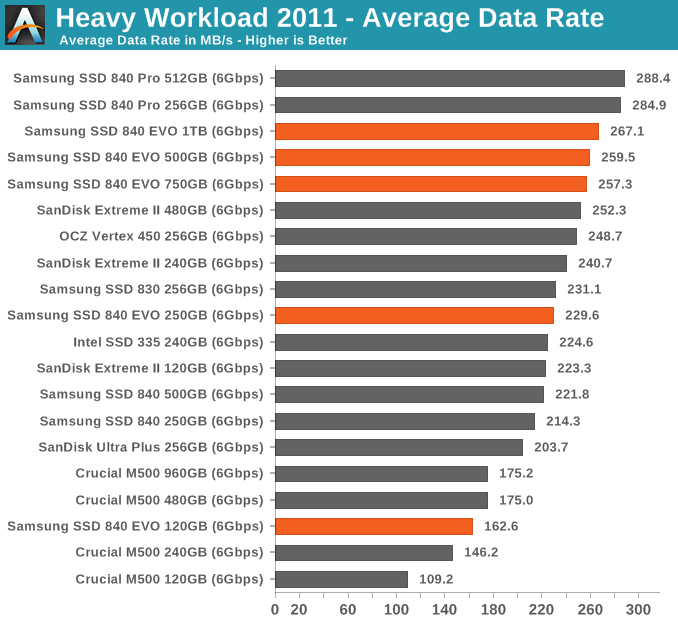
In lighter workloads than our 2013 workload the EVO still does incredibly well.
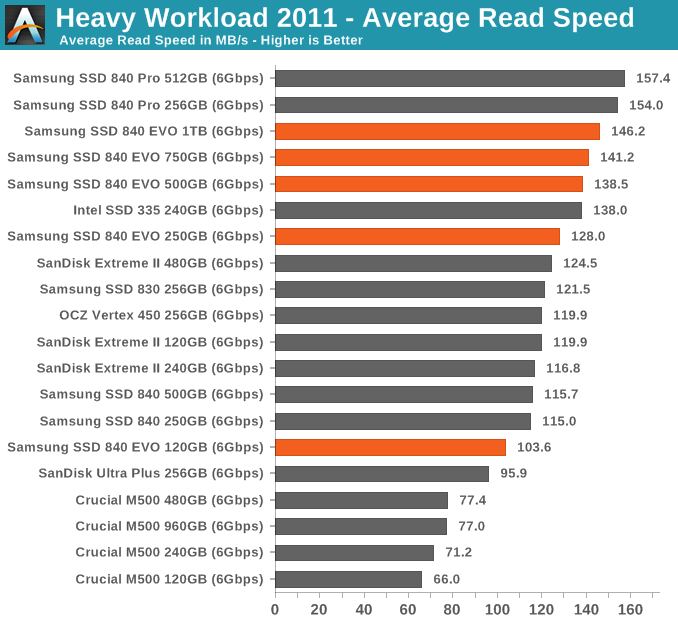
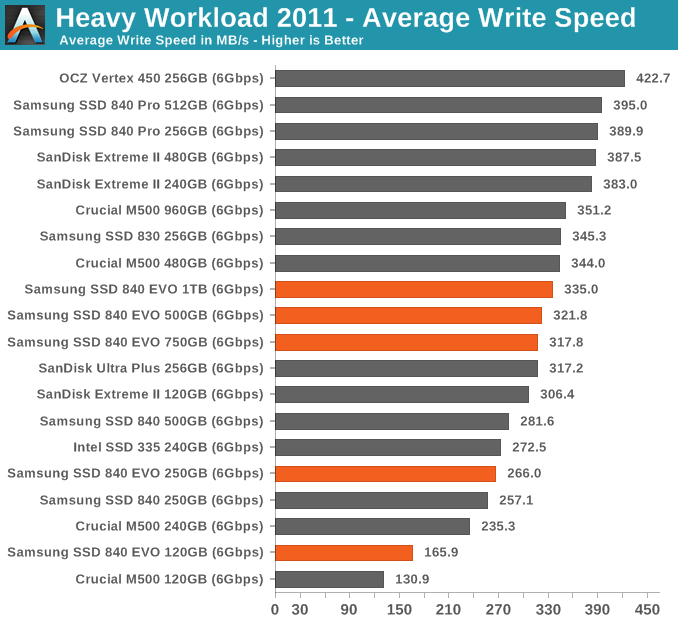
AnandTech Storage Bench 2011 - Light Workload
Our new light workload actually has more write operations than read operations. The split is as follows: 372,630 reads and 459,709 writes. The relatively close read/write ratio does better mimic a typical light workload (although even lighter workloads would be far more read centric).
The I/O breakdown is similar to the heavy workload at small IOs, however you'll notice that there are far fewer large IO transfers:
| AnandTech Storage Bench 2011 - Light Workload IO Breakdown | ||||
| IO Size | % of Total | |||
| 4KB | 27% | |||
| 16KB | 8% | |||
| 32KB | 6% | |||
| 64KB | 5% | |||
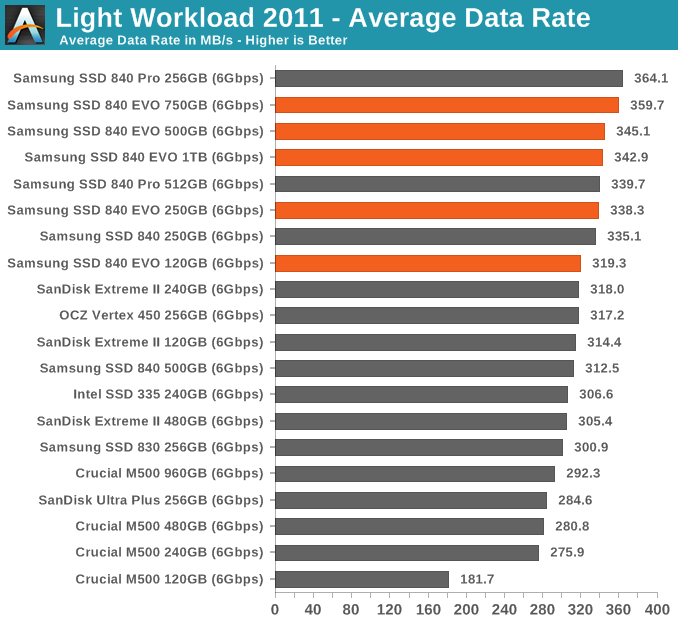
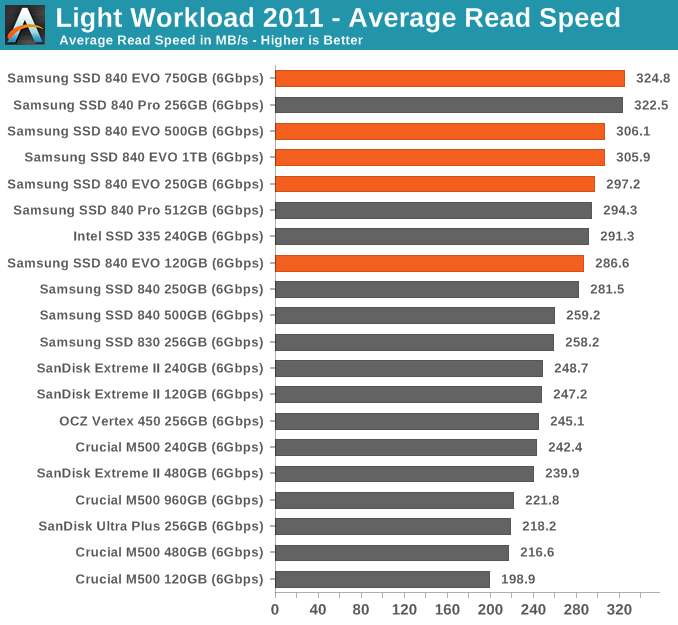
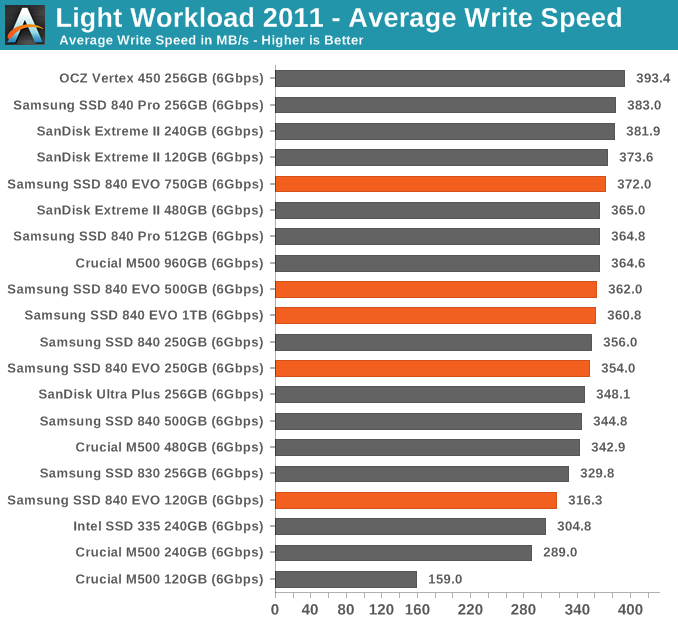










137 Comments
View All Comments
verjic - Thursday, February 13, 2014 - link
I'm talking about 120 Gb versionverjic - Thursday, February 13, 2014 - link
Also what is Write/Read IOMeter Bootup and Write/Read IOMeter IOMix - what means their speed? Thank YouAhDah - Thursday, May 15, 2014 - link
The TRIM validation graph shows a tremendous performance drop after a few gigs of writes, even after TRIM pass, the write speed is only 150MBps.Does this mean once the drive is 75%-85% filled up, the write speed will always be slow?
I'm tempted to get Crucial M550 because of this down fall.
njwhite2 - Wednesday, October 15, 2014 - link
Kudos to Anand Lal Shimpi! This is one of the finest reviews I have ever read! No jargon. No unexplained acronyms. Quantitative testing of compared items instead of reviewer bias. Explanation of why the measured criteria are imortant to the end user! Just fabulous! I read dozens of reviews each week, so I'm surprised I had not stumbled upon Anandtech before. I'm (for sure) going to check out their smartphone reviews. Most of those on other sites are written by Apple fans or Android fans and really don't tell the potential purchaser what they need to know to make the best choice for them.IT_Architect - Thursday, October 22, 2015 - link
I would be interested in how reliable they are. The reason I ask is one time, when the time the Intel SLC technology was just under two years old, and there was no MLC or TLC, I needed speed to load a database from scratch 6 times an hour during incredible traffic times. I was getting requests by users at the rate of 66 times a second per server, which each required many reads of the database per request. I couldn't swap databases without breaking sessions, and mirror and unmirror did not work well. I would have to pay a ton to duplicate a redundant array in SSDs. Then I asked the data center how many of these drives they had out there. They (SoftLayer) queried and came back with 700+. Then I asked them how many they've had go bad. They queried their records and it was none, not so much as a DOA. I reasoned from that I would be just as likely to have a chassis or disk controller go bad. None of them have any moving parts, and the drives are low power. Those were enterprise drives of course because that's all there was at that time.In 2011 I bought a Dell M6600. Dell was shipping them with the Micron SSD. I was concerned about the lifespan and I do a lot of reading and writing with it and work constantly with virtual machines while prototyping, and VM files are huge. It calculated out to 4 years. While researching, I came across that situation where Dell had "cold feet" about OEMing them due to lifespan. Micron/Intel demonstrated to them 10x the rated lifespan, which convinced Dell. There was plenty of other trouble with consumer-level SSDs at the time, which gave the technology a bad name. The Micron/Intel was one of the very few solid citizens at the time. I went with it, although I didn't buy my M6600 with it because Dell had such a premium on them. I had two problems with the drive, which by the way is still in service today. The first was the drive just stopped doing anything one day. I called Micron and it turned out to be a bug in the firmware. If I had two drives arrayed, it would have stopped both at the same time. I upgraded the firmware and never had that problem again. The next time I was troubleshooting the laptop and putting the battery in and out and the computer would no longer boot. I again called Micron. It was by design. They said disconnect the power, pull the battery, and wait one hour. I did, and it has worked perfectly since. If I had an array, it would have stopped both at the same time.
Today, the market is much more mature and the technology no longer has a bad name. A redundant array is no substitute for a backup anyway. A redundant array brings business continuity and speed. Are we just as likely or more so to have a motherboard go out? We don't have redundant motherboards unless without having another entire computer. Unlike a power supplies and CPUs, SSDs are low-current devices. I'm considering the possibility that we may be at the point, even for consumer-level drives, where redundant arrays for SSDs are just plain silly.
Gothmoth - Sunday, January 8, 2017 - link
in real life my RAPID test showed no benefits AT ALL!!all it does is making low level benchmarks look better.
you should test with real applications. RAPID is a useless feature.
jeyjey - Friday, June 7, 2019 - link
I have one of this drive. I need to find a little part that is fired, I need to replace it to try to enter the data inside. Please help.